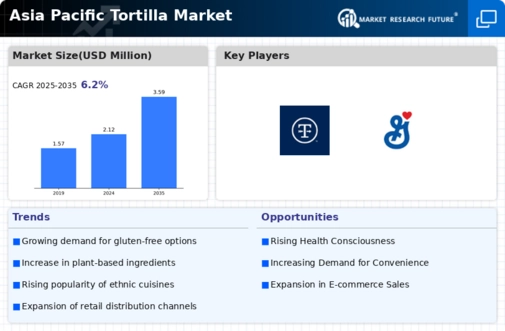Asia Pacific Tortilla Size
Asia Pacific Tortilla Market Growth Projections and Opportunities
The Asia Pacific Tortilla market is influenced by a combination of factors that collectively contribute to its growth and dynamics. One key factor is the region's shifting dietary preferences and the increasing popularity of diverse cuisines. As consumers in the Asia Pacific become more adventurous with their food choices, the demand for Mexican and Tex-Mex cuisines, where tortillas are a staple, has experienced a notable upswing. The versatility of tortillas in creating wraps, tacos, and other flavorful dishes aligns with the region's evolving culinary landscape, making them a sought-after ingredient. Economic factors play a pivotal role in shaping the Asia Pacific Tortilla market. The rising disposable income and urbanization in many countries across the region have led to changes in lifestyle and food consumption patterns. As a result, there is a growing inclination towards convenient and ready-to-eat food items, including tortillas. The fast-paced urban life, coupled with an increased focus on time-saving meal solutions, has fueled the demand for tortillas as a versatile and quick option for meals. Cultural influences also significantly impact the tortilla market in the Asia Pacific. The region's diverse cultural heritage and the openness of consumers to try new and exotic foods contribute to the popularity of tortillas. The adaptability of tortillas to different culinary traditions and their ability to complement a variety of ingredients have positioned them as a favorite among consumers seeking a fusion of flavors that bridge traditional and modern cuisines. Furthermore, agricultural factors play a role in the availability and pricing of key ingredients used in tortilla production, such as wheat or corn. Fluctuations in crop yields, weather conditions, and agricultural policies can impact the production costs and, consequently, the pricing of tortilla products. Sustainable and responsible sourcing practices are gaining importance in the market, with consumers showing a preference for products that align with environmental and ethical considerations. Health and wellness trends are influencing the Asia Pacific Tortilla market as consumers increasingly prioritize healthier food options. Manufacturers are responding by introducing tortilla variants with whole grains, multigrains, and reduced levels of additives. The demand for gluten-free and organic tortillas is also on the rise as health-conscious consumers seek alternatives that meet their dietary preferences without compromising on taste and quality. Trade and globalization are playing a significant role in the dynamics of the Asia Pacific Tortilla market. The ease of importing and exporting food products has facilitated the availability of a wide range of tortilla products from different regions. This globalization has not only expanded the variety of tortilla options for consumers but has also intensified competition among manufacturers, encouraging innovation and product differentiation. Technological advancements in food processing and packaging contribute to the market dynamics of tortillas. Improved manufacturing processes ensure product consistency and quality, while innovative packaging solutions enhance shelf life and maintain product freshness. These technological developments are crucial for meeting the demands of a competitive market and satisfying consumer expectations for convenient, high-quality food products.






Leave a Comment